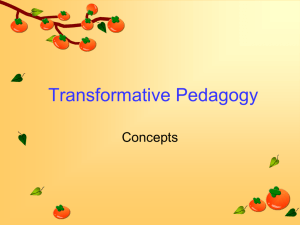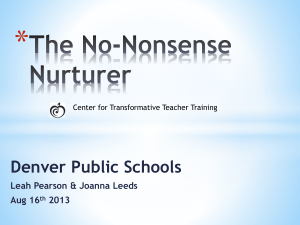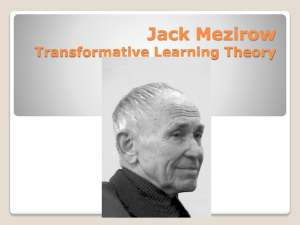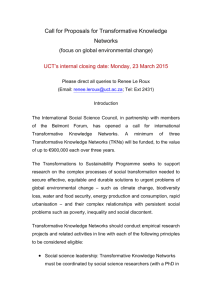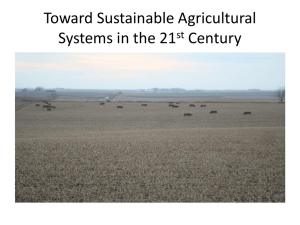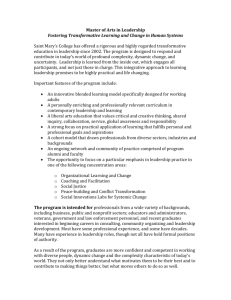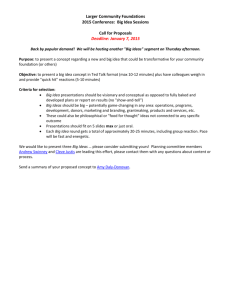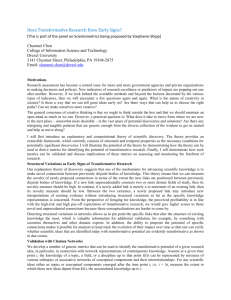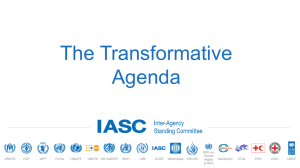Transformative Pedagogy
advertisement
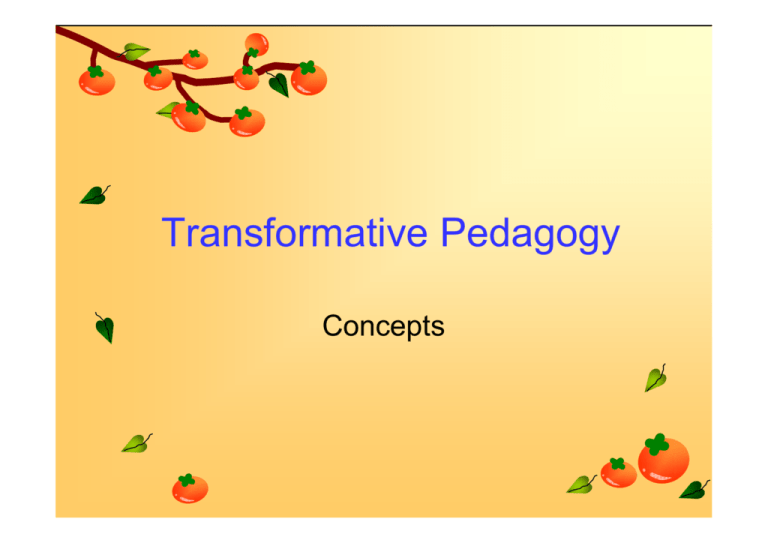
Transformative Pedagogy Concepts Definitions(Cope & Kalantzis) • • Such S h a transformative f i pedagogy d iis, we would ld argue, b based db both h on a realistic view of contemporary society (how does schooling offer cultural and material access to its institutions of power?) and on an emancipatory view of possible paths to improvement in our human futures (how can we make a better, more equal, less humanly and environmentally y damaging g g world?). ) Or,, insofar as these two g goals might at times be at odds, a transformative pedagogy could be used to support either view. Then it is up to the learner to make of the pedagogy what they will, Then, will be that a sensible conservatism (sensible for being realistic about the contemporary forces of technology, globalization and cultural change) h ) or an emancipatory i t view i which hi h wants t tto make k a ffuture t th thatt is different to the present by addressing its crises of poverty, environment, cultural difference and existential meaning. Assumptions in Schooling • Product-based and result-oriented society g = intelligence g measured by y tests • Learning • Experts would be able to decide what to teach, how to teach, and how to evaluate • All human beings are as much alike > same lessons assigned for all • The pupil’s mind is empty and wait to be filled • In a complete bureaucratic settings, it is easy for students to receive an education(and to be disengaged.)) 3 Types of Education(McGregor Education(McGregor,2008) 2008) • Transmissional ¾ Teacher is the expert and has power ¾ Curriculum focuses on subject matter ¾ No space for students’ daily life and context ¾ The information is organized in sequenced topics and units, teacher delivers and students have to master them. th ¾ The intended outcome is to pass the test by memorizing and mastering the transmitted information information. 3 Types of Education(McGregor Education(McGregor,2008) 2008) • Transactional ¾ Closer to collaborative approach ¾ The power is more likely to be shared between students and teacher. ¾ Curriculum focuses on problems and solutions by both teachers and students ¾ Jointly J i tl construct t t meaning i th thatt informs i f llearners’’ personal growth ¾ Learning is gauged by observing each students’ growth and thinking process, inquiry process, and students’ predisposition to lifelong learning. students 3 Types of Education(McGregor Education(McGregor,2008) 2008) • Transformative ¾ Place the student at the center of learning ¾ Help learners find their own inner voice and power, therefore they feel empowered to effect social change, b i about bring b t jjustice, ti peace, ffreedom, d and d other th components of human condition. ¾ Teachers have to respect and have compassions for co-learners. ¾ All ways of knowing are interconnected and enriched by each other. ¾ The desired outcome is to changechange to transfer learning into social action outside the classroom. (Sockman & Sharma , 2008) Characteristics • Transfer/Transmission to Transform ¾ From learning for information ("what we know") to learning for transformation ("how we know“). • Transformative learning often requires a “structural shift” in the way thoughts, feelings, and actions are conceptualized. This shift is at once conscious, dramatic and lasting; and it holds an opportunity to change the way we are in the world(O’Sullivan, 2004). • Self-reflectivityy / Self-recreation Good words • William Ayers(1993) ¾ ……a creative work, (in which teachers) must figure out how to create a space where students are expected to use their minds well to derive knowledge from information, information to invest though with courage courage, to connect consciousness to conduct, and so on. (p.7) • bell hooks(1994) ¾ ……against and beyond boundaries. It is that movement that makes education the practice of freedom(p.12). • Edmund V. O’Sullivan(2002) ( ) ¾ Transformative learning involves experiencing a deep, structural shift in the basic premise of thought, feeling, and actions. It is a shift of consciousness that dramatically and permanently alters our way of b i in being i the th world. ld S Such h a a shift hift iinvolves l our understanding of ourselves and our self-locations; our relationships with other humans and with the natural world; our understanding of relations of power in interlocking structures of class, race, and gender; our body-awareness; our visions of alternative approaches to living; and our sense of the possibilities for social justice and peace and personal joy. 4 Dimensions(Bill & Kalantzis Kalantzis, 2008) • Experiencing, p g, Conceptualising, p g, Analysing, y g, and Applying • Experiencing ¾ ‘Experiencing Experiencing the Known’ involves or reflecting on our own experiences, interests, perspectives, familiar forms of expression and ways of representing the world in one’s own understanding. ¾ ‘Experiencing p g the New’ entails observing g or reading g the unfamiliar, immersion in new situations and texts, reading new texts or collecting new data. 4 Dimensions(Bill & Kalantzis Kalantzis, 2008) • Conceptualising ¾ ‘Conceptualising by Naming’ involves or drawing distinctions of similarity and difference, categorising and naming. ¾ ‘Conceptualising ‘C t li i with ith Theory’ Th ’ means making ki generalisations and putting the key terms together into interpretative frameworks frameworks. 4 Dimensions(Bill & Kalantzis Kalantzis, 2008) • Analysing ¾ ‘Analysing Functionally’ includes processes of reasoning, drawing inferential and deductive conclusions, establishing functional relations such as between cause and effect and analysing logical and textual connections. ¾ ‘Analysing Analysing Critically Critically’ involves evaluation of your own and other people’s perspectives, interests and motives. 4 Dimensions(Bill & Kalantzis Kalantzis, 2008) • Applying ¾ ‘Applying Appropriately’ entails the application of knowledge and understandings to the complex diversity of real world situations and testing their validity. validity ¾ ‘Applying Creatively’ involves making an intervention in the world which is truly innovative and creative and which brings to bear the learner’s interests, experiences and aspirations. Thinking UL • Ubiquitous computing has become part of home, community, and daily lives. This technology has the potential to inspire us to transform the way we live, the way we teach, and the way we learn. • It is a radical transformation in educational practice, especially who learns from whom, where, under what circumstances, and for what and whose purpose. Thinking UL • “We need to do more than this, hence the notion of a transformed and transformative pedagogy in the environment of ubiquitous learning”(Cope & Kalantzis, 2008) • ……not to start from the side of the sender (or the teacher), but from the side of the receiver (the student). In general terms, the question then becomes how a child or learner can get access to the meanings that are available in a culture(Biesta & Miedema, 2002, p.180) Thinking UL • UL enabling bli educators d to transform f their h i instructional practices from a teacher-centric model d l to a teacher h as ffacilitator ili model d l where h inquiry based learning through ubiquitous access to technical h i l resources iis the h capstone of the classroom. Thinking UL • Internet is a relatively egalitarian environment for teaching approaches that critically examine social patterns of power and dominance. greater willingness g to • Students mayy feel a g disclose their beliefs and experiences online. • Sharing and sense of community are also vital for transformative pedagogy. • Internet has transformative potential for democracy Implications • Transformative Pedagogy g gy + Ubiquitous q Learning? g • Meyers (2008) has some suggestions based on his online teaching experiences experiences. • Creating C ti a safe f environment i t ¾ Increasing trust, climate of acceptance, positive peer i t interactions, ti and d remaining i i openness. ¾ Forums allow students to express themselves thoughtfully without interruption, interruption which is particularly significant for those who are at greater risk for g in class due to their g gender,, race,, marginalization social class, or even personality style Implications • Encouraging students to think about their experiences, beliefs, and biases ¾ Internet courses allow reflective dialogue to develop slowly over the span of several days, which can clarify l if diff differences iin perspective. ti • Using teaching strategies that promote student engagementt and d participation ti i ti ¾ Use internet adaptations and extension, ex. blogs allow ll students t d t tto publish bli h iinstantaneously t t l on th the Internet and provide the opportunity for others to respond. respond Implications • posing real-world problems that address societal inequalities • helping students implement action-oriented solutions. ¾ Internet resources can uniquely facilitate advocacy by helping students obtain necessary information, promoting communication, and enabling coordination with others who have similar concerns. ¾ Ex: E writing iti editorials dit i l or columns l iin llocall newspapers, or e-mail to legislators, producing YouTube videos…… videos Video as Resources • Ideas: Cultural Criticism & Transformation(bell hooks) ¾ http://www.youtube.com/watch?v=zQUuHFKP-9s • Practice: Digital g Bridge g Academy y ¾ http://www.youtube.com/watch?v=KpYyZOvrB8A • A Talk : Transformative Technology(Dr. Yong Zhao) ¾ http://www.youtube.com/watch?v http://www youtube com/watch?v=nGwtBc3vsj8 nGwtBc3vsj8 References • • • • • • • Ayers, W.(1993). A W (1993) T To tteach: h Th The jjourney off a tteacher. h N New Y York: k T Teachers h College Press. Biesta, G. J. J., & Miedema, S.(2002). Instruction or pedagogy? The need for a transformative conception of education. Teaching and Teacher Education, 18, 173-181. Cope, Bill and Mary Kalantzis, ‘Multiliteracies: New Literacies, New Learning’, forthcoming in Pedagogies: An International Journal. Gardner, M., & Kelly, U. (Eds.) (2008). Narrating transformative learning in education. New York: Macmillan. hooks, b.(1994). Teaching to transgress: Education as the practice of freedom. New York: Routledge. Meyers, S. A.(2008) Using transformative pedagogy when teaching online. College Teaching, 56, 219-224. O’Sullivan, E. V., Morrell, A., & O’Connor, M. A.(2002). Expanding the boundaries of transformative learning learning. New York: Palgrave Palgrave.
